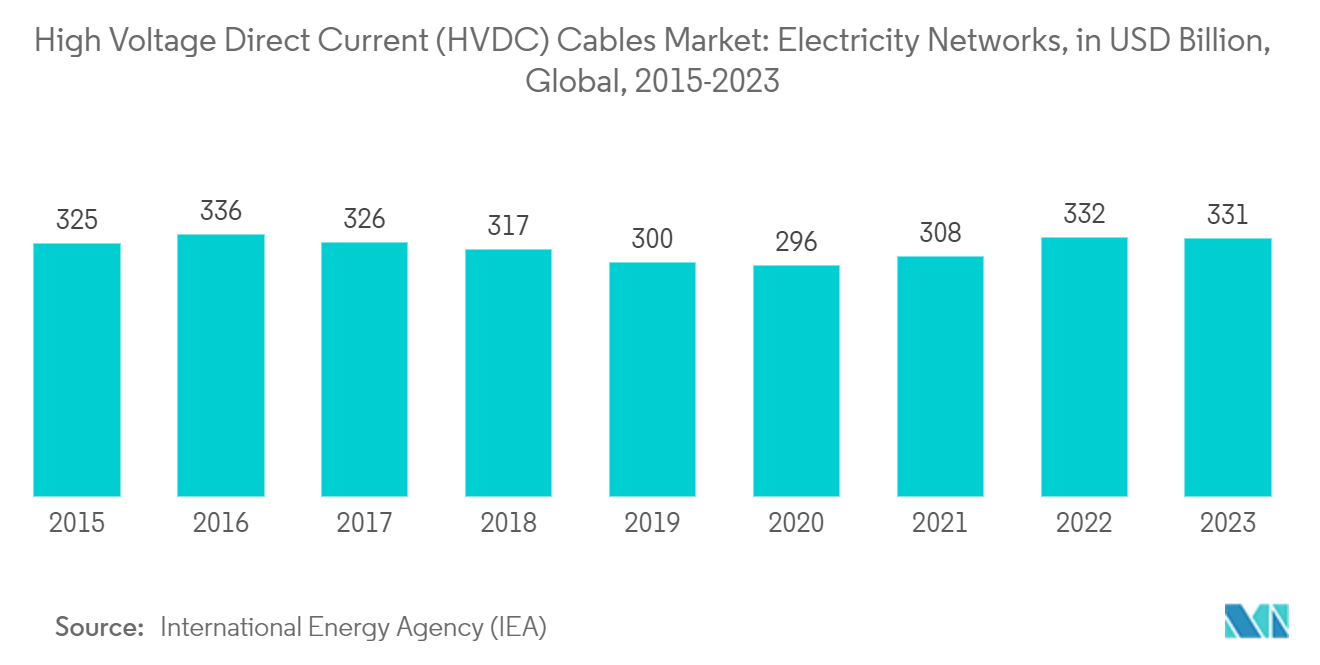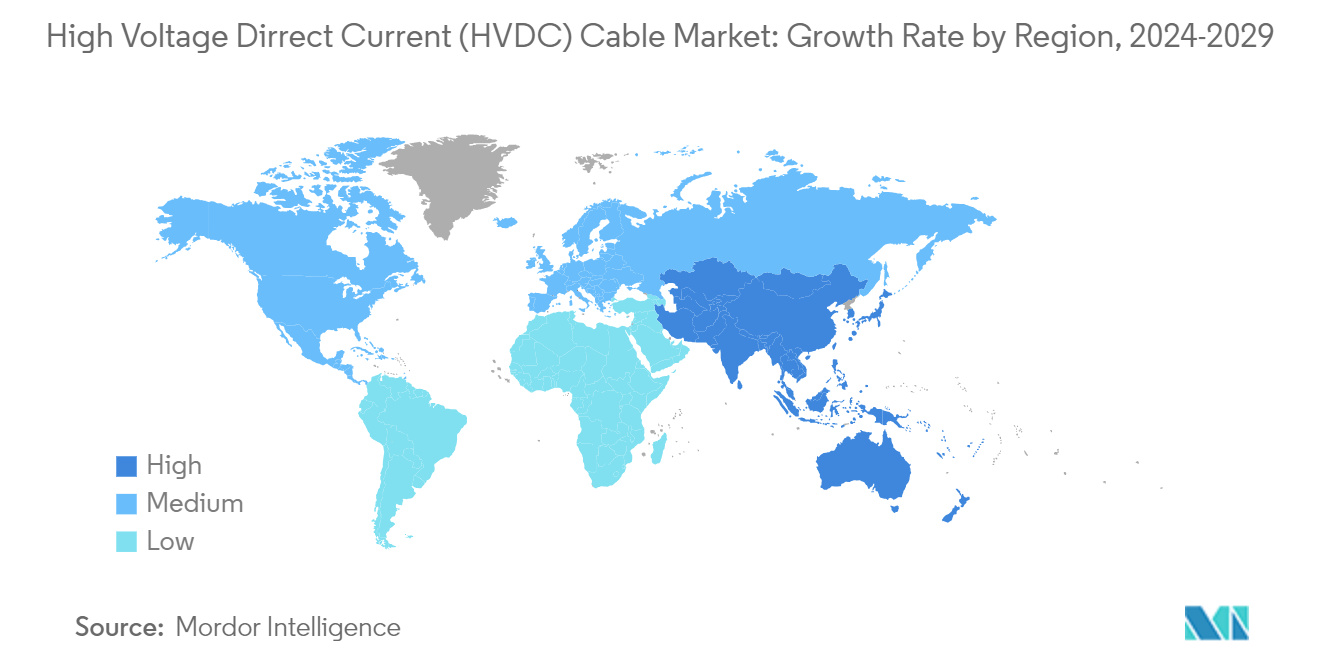Market Trends of High Voltage Direct Current (HVDC) Cables Industry
Overhead HVDC Cables to Dominate the Market
- High voltage direct current (HVDC) cables with overhead transmission lines are usually preferred for high-power and long-distance transmissions, usually above 600 km from remote power generating stations.
- Overhead lines utilize an air gap between the conductors and the ground through electrical insulation to cool the conductors. Conductors are suspended from towers by insulators made of either ceramics or polymers. However, polymer insulators are generally used for HVDC applications because of their improved pollution performance, as HVDC systems tend to attract pollution/particulates.
- High voltage overhead transmission lines are a popular means of power transmission in most of the world. Moreover, direct current decreases the total cost of long-distance power transmission with overhead lines or cables. A direct current (DC) line needs only two main conductors to lower DC electrical losses, while an alternate current (AC) line needs three. Moreover, the high-voltage overhead transmission is much less expensive to build and much quicker to repair than the underground transmission. However, it has decreased application in densely populated urban and commercial areas.
- A major factor driving the current overhead HVDC market is that the HVDC system can control power flows precisely. In HVAC systems, power flows along the path of least resistance, sometimes resulting in unequal power distribution across the transmission system. HVDC systems allow the operator to precisely control the flow across the circuit, alleviating issues on the wider power system.
- In 2023, global investments in electricity networks exceeded USD 331 billion, according to the International Energy Agency (IEA) statistics. The United States led the way, accounting for nearly 30% of investments in the sector, followed by China, with investments totaling USD 79 billion. Meanwhile, investments in Europe stood at about USD 60 billion.
- To improve business efficiency, state-owned electricity utilities across various countries, including India, Australia, China, the United Kingdom, the United Arab Emirates, and Ukraine, are gradually restructuring to fall in line with the industry’s worldwide transformation with the unbundling of services and the creation of energy markets. Therefore, there is a need for bulk energy transmission, often over long distances, that must be routed through rough terrain and environmentally sensitive areas. Utilities invest in several major projects to enhance existing transmission systems' security, capacity, and flexibility.
- In addition, with upcoming and ongoing projects related to substations in developing and underdeveloped countries, high-voltage overhead cables are also expected to grow during the forecast period. For instance, in May 2024, Portland General Electric (PGE) signed a non-binding memorandum of understanding with Grid United and Allete Inc. to develop an approximately 415-mile HVDC transmission line in the United States. The North Plains Connector project will be constructed with endpoints near Bismarck, North Dakota, and Colstrip, Montana. The project represents a total investment of USD 3.2 billion in Montana and North Dakota and is expected to create over 600 jobs during construction. Upon completion, the infrastructure will also enable additional energy production in Montana and North Dakota.
- In May 2023, Larsen and Turbo (L&T) announced securing two EPC orders in Saudi Arabia and India. The cumulative value of these projects is under USD 60 million. In Saudi Arabia, the company will establish 380 kV overhead power transmission lines connecting prominent cities on the Red Sea coast. The company will also design, supply, and build a 380 kV substation in Saudi Arabia. In India, the company will work to modernize and develop distribution infrastructure in three districts of Gujarat.
- As the overhead cable is visible, it is easy to find the location of the fault. Also, the overhead cable system is more flexible as the expansion is easily possible, thus creating a huge demand for overhead cables, further creating ample market opportunities in the coming years.

Europe to Dominate the Market
- The energy industry in Europe is transitioning from generating most of the electricity through conventional sources to generating most of the electricity from renewable sources. The region is increasing the installation of renewable sources to achieve its net zero emissions target by 2050. The region has even adopted several policies, such as the Europe Green Deal and REPowerPlan, to achieve the zero-emission targets.
- The transmission and distribution network is expanding significantly in Europe due to increasing electricity demand and the installation of renewable energy sources within the region. The countries in the region are phasing out coal and gas power plants and adopting renewable technologies. This will create transmission and distribution network expansion requirements in the upcoming years.
- According to the report published by the European Network for Transmission System Operators' Electricity, Ten-Year Network Development Plans (TYNDP) 2022 assessed 141 transmission projects, of which 85 were cross-border projects and 23 were storage projects. Overall, the TYNDP 2022 portfolio represented 43,000 km of lines or cables.
- Germany is a global leader in renewable energy integration, strongly emphasizing wind and solar power. HVDC cables transmit electricity from offshore wind farms in the North and Baltic Seas to significant population centers.
- The United Kingdom is one of the largest energy consumers in Europe, and the country is rapidly upgrading its electricity generation capacity to fulfill domestic demand and achieve climate targets. According to the United Kingdom’s Department for Business, Energy, and Industrial Strategy, the electricity generation capacity of major power producers in the country is projected to reach 185 GW in 2040.
- Moreover, in April 2023, Dogger Bank installed one of the world's first autonomous high-voltage direct current (HVDC) offshore substations. The substation is the first of three Aibel platforms to be erected at Dogger Bank, which is being built in three 1.2 GW phases named A, B, and C. The Dogger Bank A platform is 65 x 36 meters across and 39 meters high, and it sits on a four-legged steel jacket foundation structure attached to the seabed at a depth of about 28 meters. Also, in October 2023, Dogger Bank was connected to the British national grid and began exporting electricity to British homes and businesses for the first time.
- In March 2023, Terna SPA, Italy’s transmission system operator, announced plans to invest more than EUR 21 billion (USD 22.2 billion) in Italy's energy grid over 10 years as part of its 2023 development plan for the national grid. The allocated amount is 17% more than Terna's previous 10-year plan and will focus on promoting decarbonization across the country and reducing Italy's dependence on foreign supply sources. Such a scenario will strengthen the need for HVDC transmission corridors during the forecast period.
- As a result, the quest for energy security and facilitation of growing renewable energy generation with an efficient transmission infrastructure is likely to increase the demand for high-voltage direct current (HVDC) cables in Europe during the forecast period.


